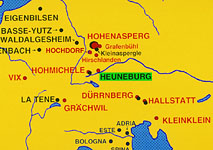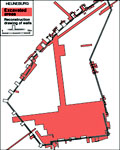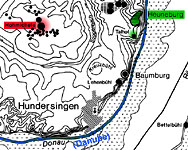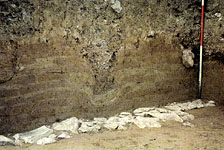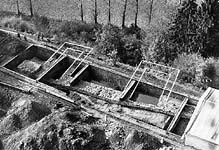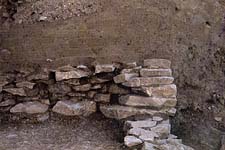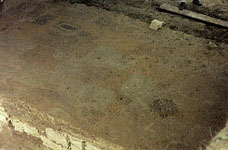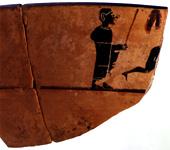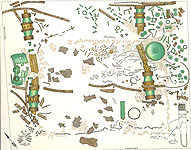Heuneberg, Germany
I. Site
II. Brick Wall and Finds
III. Hohmichele Wagon Burial
A fortified hill settlement located on the Danube, the Heuneburg has been partially excavated and lavishly although not conclusively published. note
Less than half of the interior of the fortified site has been excavated. Very few finds were made -- the floors of the houses not preserved, and the plan of the streets and dwellings is reconstructed on the basis of traces of mainly wooden posts and trenches in the ground. Among those finds that could be recovered is a great deal of local and some imported pottery (recently exhibited in Würzburg as "Luxusgeschirr keltischer Fürsten") as well as the melted remains of metal objects. Some workshops were active inside the walls.
Plan showing the oft-published
reconstruction of the "Greek" wall,
superimposed on area actually excavated.
after Gersbach 1995
The positions of the Heuneburg fortified hill
and the tumuli at Hohmichele.
after Gersbach 1995, fig. 4
The hilltop with reconstructed fortification
after Cunliffe 1979, p. 37.
The brick wall is the Heuneburg's most famous feature. Dating to
the late Hallstatt Period IVb-IVa, a wall of unfired bricks was
constructed on a stone foundation to a height of ca. 3-4 m. The
bricks are around 10 cm thick, anywhere from 24 to 90 cm on a side,
with the majority around 40 to 50 cm. Mortar 1 cm thick cemented
them together. In spite of the high quality of the clays used, a
wall of unfired bricks is quite unsuited to the southern German
climate, and it was soon replaced with local earth and timber
construction. Was a Greek architect necessary to design this ill-fated
experiment, or could a local designer have come up with the idea,
perhaps inspired by the brick walls in Italy and southern France?
after Gersbach 1995, fig. 32.2
Remains of Towers 9 and 10,and reconstruction
after Gersbach 1995, fig 20.2
Among the potsherds form the Heuneburg is a small scattering of Greek pottery, all of it either drinking or banqueting vessels (Wehgartner et al. 1995, 70.116 ff.). Part of the rim and body of an Attic kylix of the Kleinmeisterschalen type, dating to ca. 540 BCE, is one of the best-preserved among them. The scene was a generic black-figure palaistra scene; preserved are a judge and part of a wrestler.
5.6 x 15.5 cm preserved
original dia 20.9 cm
Württembergisches Landesmuseum Stuttgart
This not unproblematic burial, found under on eof the tumuli at Hohmichele to the west of the Heuneburg, has been thoroughly published by Riek; the plan is provided here for purposes of discussion in the context of late Hallstatt wagon burials and of the gender of the interred.


